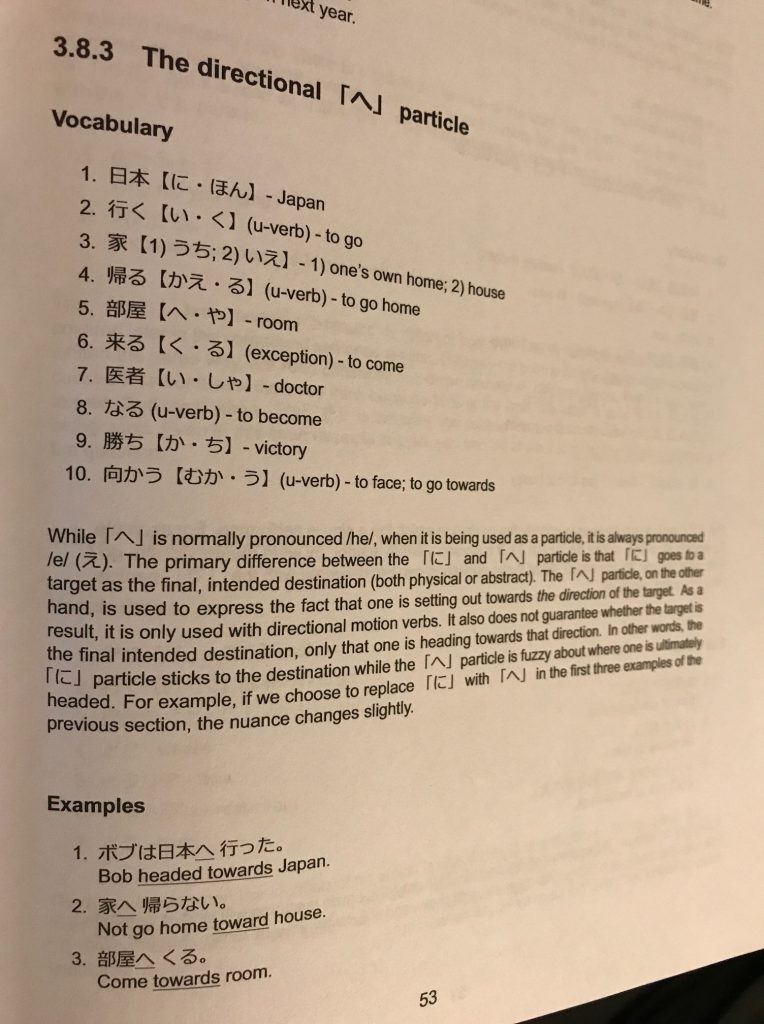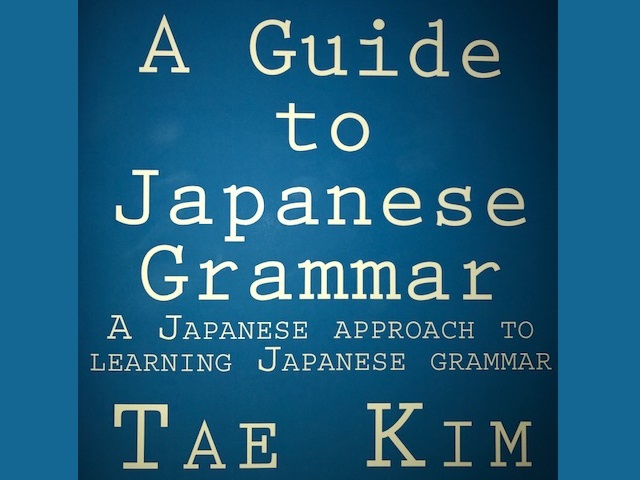If you spend any time at all learning Japanese and looking around the internet for good learning materials, you tend to run into the same names over and over again. Tae Kim’s A Guide to Japanese Grammar is one of those books that I had heard was good every time it was mentioned, but I never really got around to checking it out for myself until recently.
I picked up a copy of it on Amazon the other day and started reading it. And let me tell you, this book is GOOD!
But what makes it one of the best books for learning Japanese? Why has it gained a rank of 4.6 stars out of 5 on dozens and dozens of Amazon’s reviews?
Let me tell you why.
The Premise Behind the Book
Let’s start at the beginning. The reason why Tae Kim wrote the book is actually pretty simple: people wanted a book format of the information on his blog.
That’s right – you can get all of the same information for FREE on his blog!
If you want to check it out, here is the link: www.guidetojapanese.org
But sometimes a book is better organized than a website, which is one reasons why people might prefer this format. Or just like the other day when I was on a float trip and had no internet access, a book is perfect for those situations.
Anyway, he has a similar story to most students when they begin learning Japanese. That is, he learned a lot about the polite form of the language, but he wasn’t really able to understand any of the Japanese that he encountered in real life.
Talk about frustrating! Can you relate?
So Tae decided to learn how Japanese people really talk and use the language. Once he had learned Japanese in this way, he then started sharing everything that he learned with others.
So if your origin story sounds a little like his (or a lot), then his style of explaining Japanese may be just right you for.
The basic approach he takes to teaching you Japanese is “learn Japanese the same way that Japanese people learn it.”
More on that in the next section.
What is the Book Like?
In a word: beautiful.
I’m not kidding about that. The cover is simple with just a blue background and white lettering. I thought that it looked kind of strange at first, but I have to admit that it’s grown on me and now I really like the simplicity of it.
The book actually has a wax-like coated cover on it, which feels amazing while it’s in your hands and (I think) helps to protect it from getting dirty.
Then you open it up and it’s lot of black text on a white background (that means it’s easy on the eyes) and the font that’s been choosen for the kanji is very nice to look at.
You may have noticed that a lot of kanji have that “pixelated look” to them on the internet (if you’re on Windows), and it doesn’t look all that great.
But the kanji in this book are all smooth lines and curves.
Here’s a phrase written in kanji on the internet, and below it is the same phrase from the book:
もう売り切れみたい。
vs.
![]()
It might sound silly that I’m praising how the book looks and not the information (I’ll get to that), but the reason is because I’m very conscious about how things look to the people who are reading it, since I basically do that with each and every post on this blog.
But even though I always want things to look very pretty, the truth is that people will forgive a bad design so long as the information is extremely helpful.
Fortunately, A Guide to Japanese Grammar has both: Great visual appeal, and superb information!
So let’s talk about the important stuff: the content.
When it comes to the information taught in the book, there are a few things that really stand out.
(1) The first thing is that Tae Kim will not use Rōmaji in it. He’s got a funny 4コマ漫画 or “four cell manga” at the bottom of the homepage on his website that illustrates why he refuses to use it.
I have to admit – I laughed! It’s makes a really good point and is a nice joke at the same time.
Just so that we are all on the same page, I will explain it. You see, when people use Rōmaji to learn Japanese, the tend to use a heavy American/English accent since they are reading English letters.
But when you first learn the two kana systems, and the elemental sounds of Japanese that go with it, then you are much more likely to use correct Japanese pronunciation. More than that though, you tend to also have a better rhythm and intonation while speaking.
Do the hard work of learning hiragana and katakana first, and you will set yourself up for success when you get into the thick of things in the Japanese language.
Since you must know hiragana and katakana to be able to use the book, the beginning of it naturally goes over it and teaches it to you.
(2) The second thing is that he teaches the dictionary form of verbs first. This is keeping in line with “learning the Japanese language, the way Japanese people do.”
Most textbooks and courses teach new students the -mass form of Japanese verbs first, and leave the dictionary form until much, much later on.
I think they do that because, since the people learning it are non-native Japanese people, the instructors want you to learn polite Japanese first.
But it is the informal or dictionary form of Japanese that is spoken at home in Japan. That’s what Japanese kids learn first. And all conjugations (like the -te form, the -mass form, etc) are based off of them.
So even though it might be considered impolite, it actually makes more sense to learn Japanese verbs in this way. That is, dictionary form first and then more polite forms later on.
I would just like to add that, if you are a non-native Japanese person, then you’re allowed some leeway with the language that natives are not. The truth is that, unless you are working in Japan, nobody expects you to know the language. So even if you talk to strangers in informal Japanese, they aren’t going to hold it against you.
They will probably just be happy that you took the time to learn their mother tongue and used it to communicate with them.
(3) The third thing is that the explanations in the lessons are brief, but in-depth.
Generally speaking it will focus on a topic, like the particles が and は for example, and then there will be some vocabulary that you should take a little time to memorize becasue they will be used in the following example sentences.
These example sentences incorporate the grammar rules you just learned with the earlier vocabulary.
This is great since you not only learn new words and grammar rules, but you learn actual phrases that you can use in real life!
I’ve talked before about the importance of learning words within the context of as sentence, and this book does exactly that.
After that, it’s just rinse and repeat for the rest of the book. Read a chapter, practice the Japanese, learn it, and then do it again the next day. Pretty simple.
But it’s Not Perfect…
It moves from topic to topic quickly, so you should do the opposite and spend enough time on each part to really lock it in.
You don’t want to read a lesson and see how it refers back to previous lessons, but not remember those earlier lessons and have to go back to re-read them.
Sure, forgetting things is a natural part of learning any new skill, but if you do a good job at encoding the new information into your brain the first time, then you won’t have to keep going back to re-read sections all that often.
That brings us to perhaps the only downside to the book: rote learning of new words.
For those of you who are not sure what that means, rote learning is “a memorization technique based on repetition.” That is, you learn new words by repeating them over and over.
It’s an oldie for sure, but not necessarily a goodie. There are better and more effective ways to learn new words like mnemonics and spaced repetition.

But let’s be perfectly honest here: this book is about Japanese grammar the way that it’s used in real life!
This book is not really about learning lot of new vocabulary (although you will do that too). And it’s not intended to be a full course where, in each new lesson, you review and repeat words that you’ve previously learned in order to solidify them into your long-term memory.
You’re going to have to just keep reading and speaking the new words and phrases to move them from your short-term memory into your long-term memory.
Actually, I guess that also brings me to a second downside: no audio.
Let’s face it, this is a book. So you really can’t expect there to be audio included of native speakers for each part of the book. Once you’ve read the explanation at the beginning on Japanese pronunciation, it is going to have to suffice for you for the remainder of the book.
So be sure that you truly understand how to pronounce Japanese words.
Or you could suppliment the book by using other resources to listen to native Japanese sounds. Your choice.
This brings me to (what I sense) is a core philosophy of this book: You (the student) are responsible for your learning of Japanese.
This book does a phenomenal job at explaining concepts and providing useful examples. But it isn’t going to hold you hand and make sure that you understand each part before moving on to the next.
It will be up to you to fully understand each section, and then commit it to memory so that you can recall it later.
Final Thoughts
So, to sum it up: this book is a great guide and a fantastic reference, but you’re still going to have to do the work.
You’re still going to have to learn how to read Japanese, learn the correct sounds of the language, spend the time memorizing the new words, and then practice the example phrases over and over until they’re locked in.
If you get it, you will have perhaps the best book on Japanese grammar that’s currently out there. But be prepared to do the work so that the knowledge gets from the pages into your brain.
Having to work at it is not really a bad thing in my opinion, since most things in life take hard work anyway. You wouldn’t expect it to be easy to get in great physical shape, or to get a 4-year degree from a university, and it’s the same situation with learning Japanese.
There are certainly better and faster ways to learn the language than the rote learning that this book uses, but at the end of the day, no matter what method you use to learn Japanese, you still have to put in the time and the energy in order to succeed.
Anyway, I got my copy off of Amazon (I feel like I buy all my stuff from them these days). And actually, when I bought the physical book I also received a free copy of the Kindle version as well because it was part of the Kindle MatchBook program.
I don’t know if it is still in that program (it depends on when you’re reading this), so you probably should check it out for yourself and verify before you decide which version to get.
Check it out by clicking here, and let me know.
The Kindle version is also pretty cool since it allows the author to put in hyperlinks to articles and sites that he recommends so that all you have to do is click on a link to go there.
It also allows him to highlight certain words and sentences so that they really pop out at you and grab your attention.
Still… I think I prefer the book I can hold.
It’s like a cheat book for Japanese
Actually, have any of you guys read Harry Potter and the Half Blood Prince before? You remember how Harry gets a Potions Textbook that has all of these handwritten notes and tips written in it that he uses to do WAY better than everyone else in the class?
That’s kind of like what A Guide to Japanese Grammar reminds me of. It’s like getting the smartest students notes and advice, but this time it’s for learning Japanese instead of making potions at a wizarding school.
What can I say? I like Harry Potter comparisons. Moving on!
I wouldn’t say that this book is all you need to learn Japanese, but what I would say is that, if you want to have something on hand that you can reference whenever you have a question regarding how Japanese grammar works, then this is the best tool that I’ve come across.
If you are interested in picking up a new copy of Tae Kim’s book A Guide to Japanese Grammar and the Kindle version for FREE, you can do so easily on Amazon.com
Otherwise thanks for reading!
I’d like to hear from you guys on this!
Have you used this book before? What about the website? Is there a better book that teaches Japanese grammar?
Tell me what you think by leaving a comment!
Further Resources for Learning Japanese:
#3 Get My eBook (Secrets to Learning Japanese) for Free

またね!

I just bought this book, good review
Hey Mitchell, thank you! I hope you enjoy reading and learning from it as much as I did!
Sounds like a really fantastic resource!
Most definitely! It’s been around for quite a while, so I’m a little behind the ball just getting to it recently. Better late than never I guess!
Very well written review of the book.
Thanks! I’m glad you like it 🙂